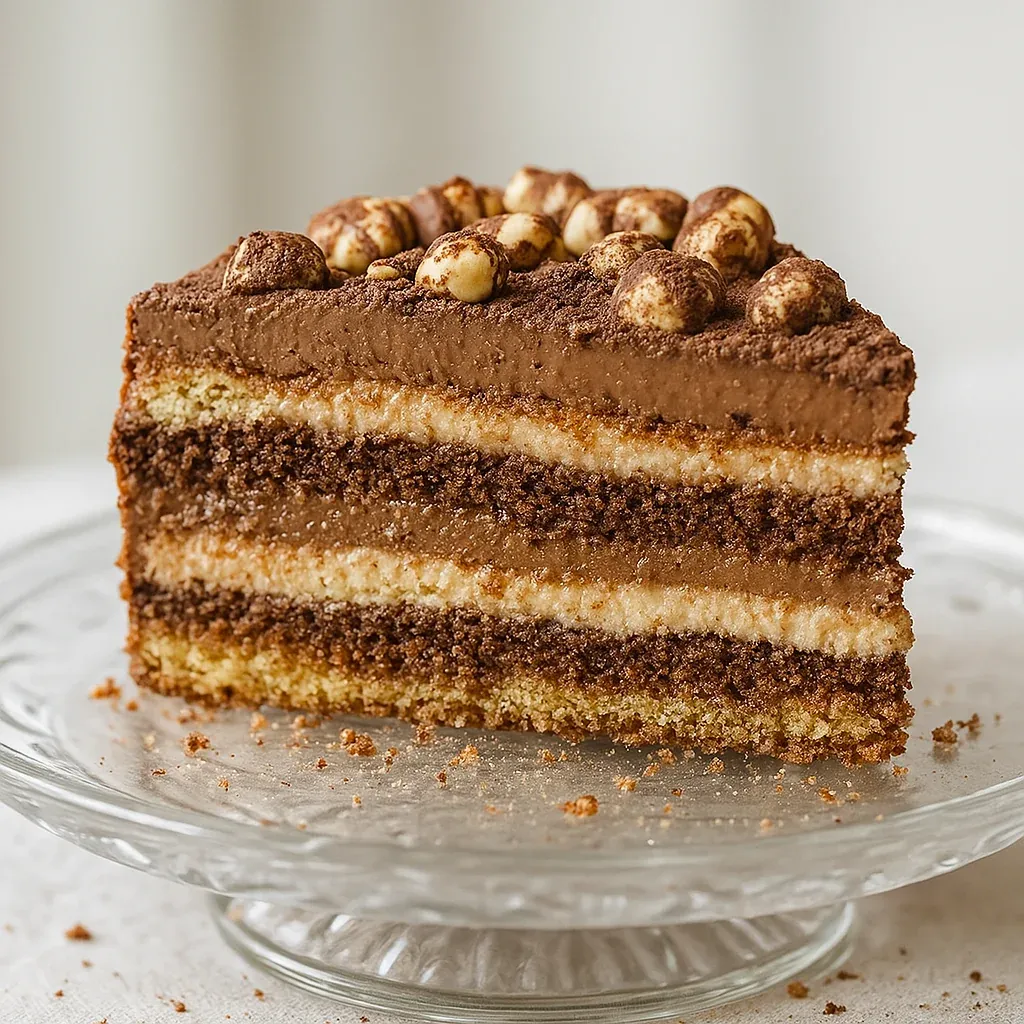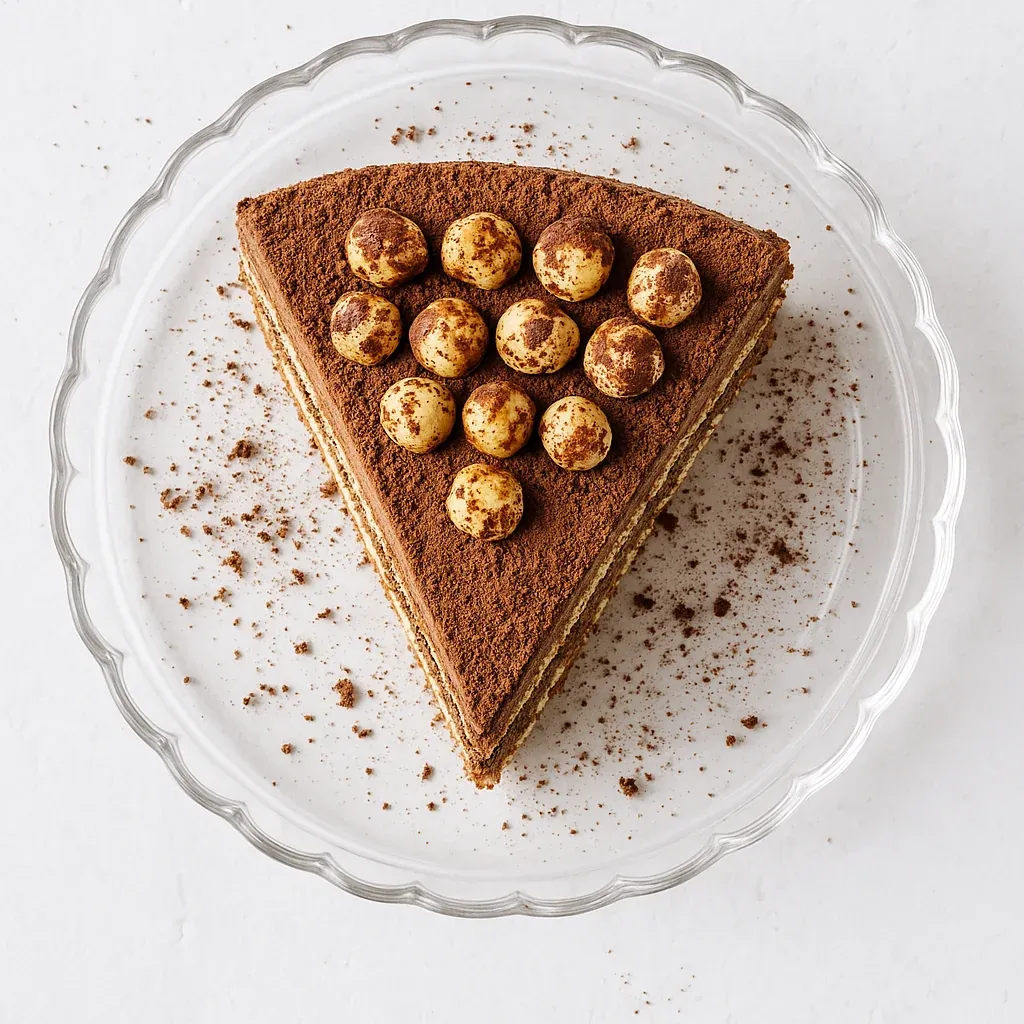 Pin
Pin
This hearty Egyptian hazelnut cake has been my family's favorite dessert for celebrations and gatherings for years. The combination of toasted hazelnuts, delicate phyllo layers, and sweet honey syrup creates a dessert that honors traditional Middle Eastern baking techniques while delivering incredible flavor.
I first discovered this recipe while traveling through Cairo's bustling marketplaces. The golden crust and nutty aroma drew me in, and after my first bite, I knew I had to recreate this treasure at home. Now my children request it for every holiday gathering.
- Hazelnuts: Use freshly roasted hazelnuts for the best flavor and aroma. Look for whole nuts with tight skins and no signs of mold.
- Phyllo Dough: Select high quality thin sheets that aren't dried out. Keep them covered with a damp cloth while working to prevent cracking.
- Honey: Choose a light floral honey for the syrup. Orange blossom or wildflower varieties complement the hazelnuts beautifully.
- Cinnamon: Invest in fresh ground cinnamon for warming notes. The Ceylon variety offers a more complex flavor profile.
- Cardamom: Fresh ground cardamom pods provide the most aromatic quality. The gentle floral notes enhance the honey syrup perfectly.
- Cloves: Use sparingly as they can overpower. Fresh ground cloves deliver the most intense flavor.
- Butter: Use unsalted butter to control the saltiness of the final dessert. European style butter with higher fat content creates richer layers.
Step-by-Step Instructions
- Prepare the Hazelnuts:
- Toast hazelnuts in a 350°F oven for 8 to 10 minutes until golden and fragrant. The skins should begin to crack slightly. Place the hot nuts in a clean kitchen towel and rub vigorously to remove most of the skins. Allow to cool completely before processing in a food processor until finely ground but not turning into butter. This creates the perfect texture for your cake base.
- Create the Hazelnut Filling:
- Combine the ground hazelnuts with 1/2 cup sugar, 1 teaspoon cinnamon, 1/2 teaspoon cardamom, and 1/4 teaspoon cloves in a large bowl. Mix thoroughly to ensure even distribution of the spices throughout the nut mixture. The filling should be cohesive but still somewhat loose and granular rather than pasty.
- Prepare the Phyllo Layers:
- Melt 1 cup of butter in a small saucepan over low heat. Carefully brush a 9x13 inch baking pan with melted butter. Lay one sheet of phyllo in the pan and brush generously with butter. Continue this process for 8 sheets, creating a sturdy base layer. The butter between each sheet is crucial for the flaky texture and golden color.
- Add the Filling:
- Spread half of the hazelnut mixture evenly over the phyllo base, pressing gently to create a uniform layer. Continue layering 4 more buttered phyllo sheets on top of the filling. Add the remaining hazelnut mixture, spreading evenly across the surface. Top with 8 more buttered phyllo sheets, brushing the final layer generously with butter.
- Score and Bake:
- With a sharp knife, carefully score the top layers of phyllo into diamond or square shapes, cutting about halfway through the layers. This allows the syrup to penetrate while maintaining the cake's structure. Bake in a preheated 350°F oven for 45 to 50 minutes, until the top is golden brown and crisp.
- Prepare the Honey Syrup:
- While the cake bakes, combine 1 cup honey, 1 cup sugar, 1 cup water, and 1 tablespoon lemon juice in a medium saucepan. Bring to a boil over medium heat, then reduce heat and simmer for 15 minutes until slightly thickened. The syrup should coat the back of a spoon but still pour easily.
- Finish with Syrup:
- Remove the cake from the oven and immediately pour the warm honey syrup evenly over the hot cake. The sizzling sound is perfect – it means the syrup is being absorbed properly. Allow the cake to cool completely in the pan, about 4 hours or overnight, before serving to allow the flavors to meld and the syrup to fully absorb.

My favorite part of making this cake is toasting the hazelnuts. The aroma fills my kitchen with the most incredible nutty scent that immediately transports me back to that marketplace in Cairo. My grandmother taught me to listen for the soft popping sound that indicates perfectly toasted nuts rather than relying solely on color.
Cultural Significance
Egyptian hazelnut cake represents centuries of culinary tradition dating back to ancient Egypt. The dessert showcases the importance of nuts in Middle Eastern cuisine, where hazelnuts were considered precious ingredients reserved for special occasions. During religious festivals and family celebrations, this cake would appear as a centerpiece dessert, symbolizing prosperity and abundance for the coming year.
Unlike Western cakes that use chemical leavening agents, this traditional Egyptian pastry relies on the paper-thin phyllo layers to create its characteristic texture. This technique demonstrates the skill of Egyptian bakers who perfected the art of creating these delicate layers long before modern baking methods existed. Each slice reveals the beautiful stratification of crisp dough and nutty filling—a testament to the care taken in its preparation.
Storage Tips
For optimal freshness, store your Egyptian hazelnut cake at room temperature in an airtight container. The cake actually improves over the first 24 hours as the syrup continues to permeate the layers and the flavors deepen. Avoid refrigeration as it can cause the phyllo to lose its delicate crispness.
If you need to store the cake longer than a week, freezing works surprisingly well. Cut the cake into individual portions, wrap each piece tightly in plastic wrap, then aluminum foil, and freeze for up to three months. To serve, simply unwrap and allow to come to room temperature naturally for about two hours. The texture remains remarkably intact, though the very top layer might lose some of its crispness.

Serving Suggestions
This Egyptian hazelnut cake pairs beautifully with strong coffee or tea. For a traditional experience, serve alongside Turkish coffee with cardamom—the bitter coffee perfectly balances the cake's sweetness. For a more modern approach, a dollop of lightly sweetened whipped cream flavored with orange blossom water creates a magnificent contrast to the crisp texture.
For an elegant presentation, dust each slice with a light coating of powdered sugar just before serving. The white powder against the golden cake creates a stunning visual effect. You can also garnish with additional chopped hazelnuts or a light drizzle of honey for those who enjoy extra sweetness.
Recipe FAQs
- → What makes Egyptian hazelnut cake unique?
This cake is unique because of its rich layers of phyllo dough, a fragrant hazelnut filling, and honey syrup, all inspired by the baking traditions of Egypt.
- → Can I make variations of the hazelnut cake?
Yes! You can enhance the flavor with chocolate ganache, cocoa layers, or even add modern twists like flavored syrups and spices.
- → How should I store Egyptian hazelnut cake?
Store it in an airtight container at room temperature for 3 days or refrigerate for up to a week. You can also freeze it for 2 months secured in plastic wrap and foil.
- → What are the best flavor pairings for this cake?
This cake pairs wonderfully with Arabica coffee, mint tea, or jasmine-infused tea to complement its nutty and floral flavors.
- → What ingredients are essential for this dessert?
Core elements include finely ground hazelnuts, thin phyllo dough sheets, honey syrup, and warm spices like cinnamon and cardamom for depth of flavor.
- → What inspired the Egyptian hazelnut cake?
It draws inspiration from ancient Egyptian baking traditions, combining local ingredients like nuts and honey with Middle Eastern pastry techniques.
